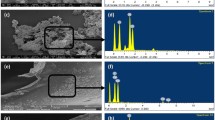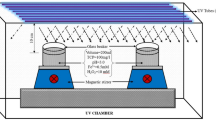Abstract
Laboratory evaluations were conducted for 94 weeks to compare, under static conditions, residue levels maintained in water treated with three polyvinyl chloride pellet formulations of fenitrothion. The results showed that foamed formulation (polyvinyl chloride + dioctyl phthalate + Triton X-100 + ammonium carbonate + citric acid + water + fenitrothion) gave the highest rates in the percentage of fenitrothion released followed by expanded formulation (polyvinyl chloride + dioctyl phthalate + Triton X-100 + fenitrothion), while non-expanded formulation (polyvinyl chloride + dioctyl phthalate + fenitrothion) gave the least.
The records indicated that increasing both the exposure time of formulations tested into the water and the percentage of active ingredient in the present formulations increased the amount of fenitrothion released from these formulations. However, all tested formulations gave low-initial rate of release.
The results showed that there were two rates of release of fenitrothion. In the first step, the non-expanded formulation gave a slow rate of release, expanded formulation gave a moderate rate of release, and foamed formulation gave a fast release. In the second step, the release rate of fenitrothion was slow for all tested formulations.
Résumé
Les évaluations faites au labouratoire durant 94 semaines pour comparer sous des conditions satables des niveaux résiduels maintenus dans l’eau traitée avec trois polyvinyl chloride formulations de fenitrothion. Les resultats ont montre que les formulations gonflées (polyvinyl chloride + dioctyl phthalate + Triton X-100 + ammonium carbonate + citric acid + eau + fenitrothion) ont donné les plus hauts degrés dans les pourcentages du fenitrothion detaché suivi par des formulations soit dilatées (polyvinyl chloride + diocytyl phthalate + Triton X-100 + fenitrothion), et non dilatées (polyvinyl chloride + dioctyl phthalate + fenitrothion). Les resultats ont indiqué que l’accroissement de deux du temps de le exposition de la formulation dans l’eau et le pourcentage de la matière active dans les formulations ont augmenté la quantité de la fenitrothion detachée.
Les resultats ont montré qu’il y a deux degrés de détachements de fenitrothion. Dans la première étape, la formulation non dilatée donna un degré lent de détachement tandis que la formulation dilatée donna un degré modéré de detachement et la formulation gonflee donna un degré rapide de détachement. En deuxième étape, toutes les formulations ont donné un degré lent de détachement.
Similar content being viewed by others
References
Al-Biltagy A. M. I. (1983) Studies on formulations of certain pesticides in relation to their toxicity. M.Sc. thesis. Faculty of Agriculture, University of Alexandria, Egypt.
Anonymous (1963) Sumithion, Technical Manual, pp. 1–52. Sumitomo Chemical Co. Ltd, Osaka, Japan.
Miles J. W. and Woehst J. E. (1969) Formulations for controlled-release of abate in water. In Pesticidal Formulation Research. Advanced in Chemistry, Ser. No. 86, pp. 183–191. American Chemical Society, Washington.
Nasef O. B. and Kassem Sh. M. I. (1981) Plastic formulations of urea. Alex. J. Agrie. Res. 29, 1487–1497.
Saleh M. S., Gaaboub I. A. and Kassem Sh. M. I. (1981) Larvicidal effectiveness of three controlled-release formulations of dursban and dimilin on Culex pipiens L. and Aedes aegypti (L.). J. agrie. Sci., Camb. 97, 87–96.
Sciarra J. and Patel S. P. (1976) In vitro release of therapeutically active ingredient from polymer matrices. J. Pharmac. Sci. 65, 1519–1522.
Whitlaw J. T. and Evans E. S. (1968) Selected plastic formulations for use as mosquito larvicides. J. econ. Ent. 61, 889–892.
Author information
Authors and Affiliations
Rights and permissions
About this article
Cite this article
Kassem, S.M.I., Saleh, M.S., Aly, M.I. et al. Formulations for Controlled-Release of Fenitrothion in Water. Int J Trop Insect Sci 6, 613–616 (1985). https://doi.org/10.1017/S1742758400009206
Received:
Revised:
Published:
Issue Date:
DOI: https://doi.org/10.1017/S1742758400009206




